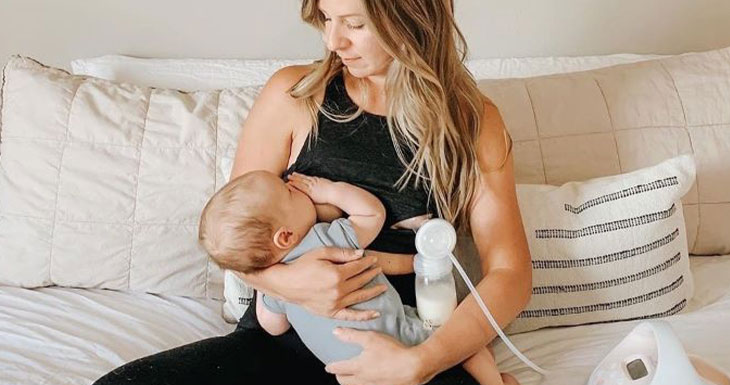HELP! My period is back! WHAT NOW?

Jacque Ordner BSN, RN, IBCLC
If you’re nursing or pumping for your little one, it can be months before your period returns. Many moms consider this a bonus of breastfeeding! However, every mother is different and that means some moms can experience the return of ovulation and their period just a few short months (or sooner) after delivery. Maybe you’ve heard of the dreaded supply dip that commonly occurs with the return of menstruation. Fear not! Our tips can help you adjust and adapt with hormonal changes and their effects on your supply.
Tip #1. Don’t assume you can’t get pregnant before your period returns! Current evidence tells us that fertility returns in stages, and this means a postpartum mother can ovulate well before her period has returned. For moms not looking to become pregnant just yet, it’s important to take necessary precautions. Non-hormonal types of birth control are the least disruptive to milk supply, so talk with your IBCLC and your doctor to determine which option is best for you.
Tip #2 Keep calm and nurse or pump on! A period related supply dip might be enough to keep you up at night, but the best thing you can do is keep nursing or pumping frequently! Some babies will nurse less enthusiastically during this time. This could be due to subtle changes in milk flavor. Breastmilk becomes a bit saltier and less sweet during mom’s period. If your baby is nursing less, it’s important to pump in order to provide adequate stimulation and drainage of the breasts. This helps safeguard against the dip in supply becoming permanent. If baby seems dissatisfied with the flow, try switching back and forth between breasts multiple times during a nursing session. This triggers multiple let-downs and can help boost supply! Pumping moms often get discouraged during this monthly dip and will shut the pump off early or skip sessions altogether. Avoid this pitfall! Any reduction in stimulation or milk removal can lead to milk supply decrease. Keep pumping on your normal schedule even if the milk stops flowing earlier than usual and even if you’re getting less than your typical output. Consider adding in a power pumping session or even mini pumping sessions to help your supply bounce back once your period is over.
Tip #3 Address nipple tenderness. It can be shocking to experience new nipple tenderness when you were previously nursing and pumping comfortably. This new pain can lead to reduced pumping and nursing. Nipple soreness is commonly associated with hormone changes once a mom’s cycle returns, but it doesn’t have to be a deal breaker. Consider trying new nursing positions like koala or laid back. If nursing is too painful, consider pumping every other feeding to provide some relief. If pumping is painful, a temporary change in flange size might help. Some moms find pumping with a larger size to be more comfortable during this time of their cycle. Lowering the vacuum can help too! If you haven’t tried a slower cycle like cycle 38 on your S1 or S2, we highly recommend it! Don’t forget to use hands on pumping techniques to improve the effectiveness of your pump sessions. Hydrogel pads are also super soothing and can get you through until the temporary tenderness subsides.
Tip #4 Nourish yourself well. Eating well and staying hydrated are keys to good health in any situation, but even more so for lactating mothers during their period! Iron is an important component of red blood cells. Choosing iron-rich foods can help replace iron lost during your period. Pairing those iron-rich foods with foods rich in vitamin-C for will further enhance absorption. Wash down those iron and vitamin-C rich foods with at least 3.8 liters of water as recommended by The Institute of Medicine (USDA) for lactating women. Consuming adequate fluids not only supports milk making, but can also help relieve symptoms of bloating and constipation often associated with menstruation. Concerned about a dip in supply? Talk with your doctor about adding in a calcium/magnesium supplement starting at the time of ovulation and continuing through the first few days of your period.
Are you experiencing a dip in supply? Nipple tenderness got you down? We can help! Schedule your free consultation with one of our International Board Certified Lactation Consultants HERE. You can also reach us by emailing ibclc@spectrababyusa.com We’re here for you!!!
References
Bonyata, K. (2020, April 08). Natural treatments for nursing moms • KellyMom.com. Retrieved December 04, 2020, from https://kellymom.com/bf/can-i-breastfeed/herbs/natural-treatments/
Dullo, P., & Vedi, N. (2008). Changes in serum calcium, magnesium and inorganic phosphorus levels during different phases of the menstrual cycle. Journal of Human Reproductive Sciences, 1(2), 77. doi:10.4103/0974-1208.44115
Hartmann, P. E., & Prosser, C. G. (1982). Acute changes in the composition of milk during the ovulatory menstrual cycle in lactating women. The Journal of Physiology, 324(1), 21-30. doi:10.1113/jphysiol.1982.sp014098
Jackson, E., & Glasier, A. (2011). Return of Ovulation and Menses in Postpartum Nonlactating Women. Obstetrics & Gynecology, 117(3), 657-662. doi:10.1097/aog.0b013e31820ce18c
Read “Dietary Reference Intakes for Water, Potassium, Sodium, Chloride, and Sulfate” at NAP.edu. (n.d.). Retrieved December 04, 2020, from https://www.nap.edu/read/10925/chapter/1



Leave a Reply
Want to join the discussion?Feel free to contribute!